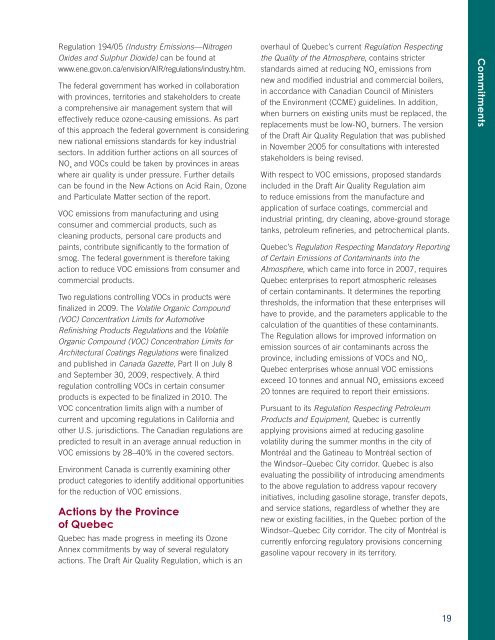2010 Progress Report - International Joint Commission
2010 Progress Report - International Joint Commission
2010 Progress Report - International Joint Commission
You also want an ePaper? Increase the reach of your titles
YUMPU automatically turns print PDFs into web optimized ePapers that Google loves.
Regulation 194/05 (Industry Emissions—Nitrogen<br />
Oxides and Sulphur Dioxide) can be found at<br />
www.ene.gov.on.ca/envision/AIR/regulations/industry.htm.<br />
The federal government has worked in collaboration<br />
with provinces, territories and stakeholders to create<br />
a comprehensive air management system that will<br />
effectively reduce ozone-causing emissions. As part<br />
of this approach the federal government is considering<br />
new national emissions standards for key industrial<br />
sectors. In addition further actions on all sources of<br />
NO x<br />
and VOCs could be taken by provinces in areas<br />
where air quality is under pressure. Further details<br />
can be found in the New Actions on Acid Rain, Ozone<br />
and Particulate Matter section of the report.<br />
VOC emissions from manufacturing and using<br />
consumer and commercial products, such as<br />
cleaning products, personal care products and<br />
paints, contribute signifi cantly to the formation of<br />
smog. The federal government is therefore taking<br />
action to reduce VOC emissions from consumer and<br />
commercial products.<br />
Two regulations controlling VOCs in products were<br />
fi nalized in 2009. The Volatile Organic Compound<br />
(VOC) Concentration Limits for Automotive<br />
Refi nishing Products Regulations and the Volatile<br />
Organic Compound (VOC) Concentration Limits for<br />
Architectural Coatings Regulations were fi nalized<br />
and published in Canada Gazette, Part II on July 8<br />
and September 30, 2009, respectively. A third<br />
regulation controlling VOCs in certain consumer<br />
products is expected to be fi nalized in <strong>2010</strong>. The<br />
VOC concentration limits align with a number of<br />
current and upcoming regulations in California and<br />
other U.S. jurisdictions. The Canadian regulations are<br />
predicted to result in an average annual reduction in<br />
VOC emissions by 28–40% in the covered sectors.<br />
Environment Canada is currently examining other<br />
product categories to identify additional opportunities<br />
for the reduction of VOC emissions.<br />
Actions by the Province<br />
of Quebec<br />
Quebec has made progress in meeting its Ozone<br />
Annex commitments by way of several regulatory<br />
actions. The Draft Air Quality Regulation, which is an<br />
overhaul of Quebec’s current Regulation Respecting<br />
the Quality of the Atmosphere, contains stricter<br />
standards aimed at reducing NO x<br />
emissions from<br />
new and modifi ed industrial and commercial boilers,<br />
in accordance with Canadian Council of Ministers<br />
of the Environment (CCME) guidelines. In addition,<br />
when burners on existing units must be replaced, the<br />
replacements must be low-NO x<br />
burners. The version<br />
of the Draft Air Quality Regulation that was published<br />
in November 2005 for consultations with interested<br />
stakeholders is being revised.<br />
With respect to VOC emissions, proposed standards<br />
included in the Draft Air Quality Regulation aim<br />
to reduce emissions from the manufacture and<br />
application of surface coatings, commercial and<br />
industrial printing, dry cleaning, above-ground storage<br />
tanks, petroleum refi neries, and petrochemical plants.<br />
Quebec’s Regulation Respecting Mandatory <strong>Report</strong>ing<br />
of Certain Emissions of Contaminants into the<br />
Atmosphere, which came into force in 2007, requires<br />
Quebec enterprises to report atmospheric releases<br />
of certain contaminants. It determines the reporting<br />
thresholds, the information that these enterprises will<br />
have to provide, and the parameters applicable to the<br />
calculation of the quantities of these contaminants.<br />
The Regulation allows for improved information on<br />
emission sources of air contaminants across the<br />
province, including emissions of VOCs and NO x<br />
.<br />
Quebec enterprises whose annual VOC emissions<br />
exceed 10 tonnes and annual NO x<br />
emissions exceed<br />
20 tonnes are required to report their emissions.<br />
Pursuant to its Regulation Respecting Petroleum<br />
Products and Equipment, Quebec is currently<br />
applying provisions aimed at reducing gasoline<br />
volatility during the summer months in the city of<br />
Montréal and the Gatineau to Montréal section of<br />
the Windsor–Quebec City corridor. Quebec is also<br />
evaluating the possibility of introducing amendments<br />
to the above regulation to address vapour recovery<br />
initiatives, including gasoline storage, transfer depots,<br />
and service stations, regardless of whether they are<br />
new or existing facilities, in the Quebec portion of the<br />
Windsor–Quebec City corridor. The city of Montréal is<br />
currently enforcing regulatory provisions concerning<br />
gasoline vapour recovery in its territory.<br />
Commitments<br />
19
















